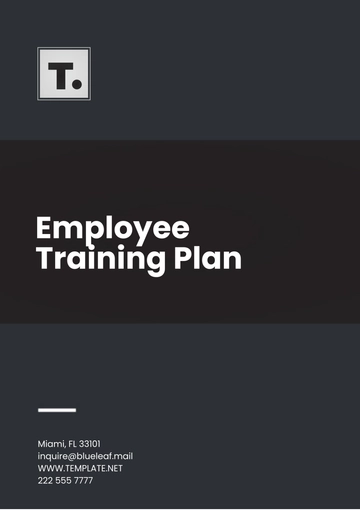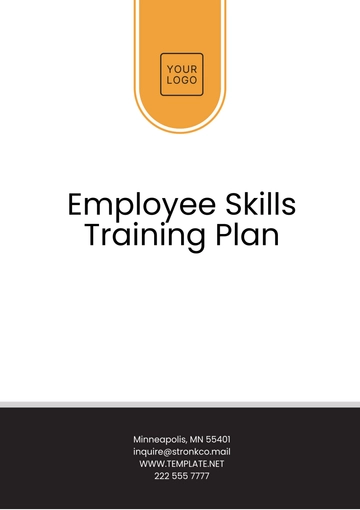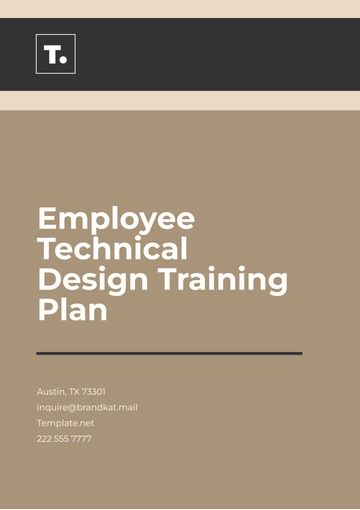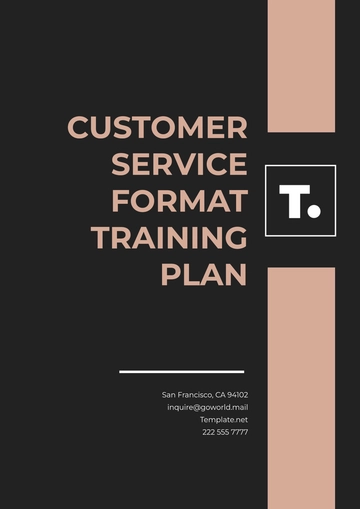Free Annual Employee Training Plan

I. Introduction
This Annual Employee Training Plan outlines a strategic approach to enhance our workforce's skills, knowledge, and capabilities. Recognizing the value of continuous learning, this plan aligns training objectives with the company’s overall mission and goals, fostering a knowledgeable and adaptable workforce that drives sustainable growth and competitiveness.
II. Training Objectives
The primary objectives of this training plan focus on strengthening employee performance, supporting individual growth, reducing skill gaps, and increasing job satisfaction, ultimately benefiting both employees and the organization.
Improve Employee Performance
Training will provide employees with the latest skills and techniques to enhance productivity, efficiency, and quality in their work.Promote Personal and Professional Development
By creating growth opportunities, the training program supports employees’ readiness for future roles, promoting career progression and motivation.Reduce Skill Gaps
Addressing identified skill deficiencies through targeted training ensures that employees remain proficient in their current roles and prepared for evolving job demands.Enhance Job Satisfaction
A robust training environment fosters a culture of learning, promoting employee morale, confidence, and long-term commitment to the organization.
III. Training Needs Assessment
To ensure alignment with company and employee needs, a thorough training needs assessment is conducted. This process involves:
Skills Gap Analysis: Reviewing current skill levels and identifying areas requiring development.
Employee Self-Assessments: Encouraging employees to self-assess and identify their training needs.
Managerial Input: Gathering feedback from supervisors regarding skill gaps within their teams.
Strategic Business Goals: Align training topics with the company's objectives to ensure relevance and maximize impact.
IV. Training Implementation
The training plan consists of various modules, each addressing a specific skill area and tailored to meet diverse employee needs. Delivery methods are chosen to cater to different learning preferences, ensuring accessibility and engagement.
Training Modules
Communication Skills: Focuses on effective interpersonal and professional communication.
Leadership Development: Designed to cultivate leadership skills in preparation for future managerial roles.
Technical Skills Enhancement: Provides up-to-date training in specialized skills required for specific roles.
Compliance Training: Ensures adherence to regulatory and ethical standards within the industry.
Delivery Methods
Workshops and Seminars: Interactive sessions that foster hands-on learning and group collaboration.
Online Courses and Webinars: Flexible learning opportunities that can be accessed remotely.
On-the-Job Training: Practical, real-world training conducted during work hours to apply skills immediately.
Mentorship Programs: Pairs employees with experienced mentors to guide personal and professional growth.
V. Schedule and Duration
A structured schedule ensures that training is consistent and ongoing, with frequencies adjusted according to the content and skill type:
Training Module | Frequency | Duration |
|---|---|---|
Communication Skills | Quarterly | 8 hours |
Leadership Development | Bi-Annually | 16 hours |
Technical Skills Enhancement | Monthly | 4 hours |
Compliance Training | Annually | 6 hours |
VI. Evaluation and Feedback
To maintain high standards, the training program will be continually evaluated and improved based on feedback, performance metrics, and assessment outcomes.
Methods of Evaluation
Pre and Post-Training Assessments: Measures knowledge gained and skills improved.
Employee Surveys: Gathers employee perceptions and satisfaction with the training content and format.
Feedback Sessions: Provides a platform for employees and trainers to discuss areas for improvement.
Continuous Improvement
Data Analysis: Compiling and analyzing feedback data to identify trends and areas for enhancement.
Content and Delivery Updates: Making regular adjustments to training materials, methods, and schedules based on feedback.
Goal Review: Ensuring that training remains aligned with evolving business goals and skill requirements.
VII. Budget and Resource Allocation
A well-defined budget ensures that the training program is adequately funded and sustainable. This section outlines:
Training Costs: Projected expenses for training materials, technology, instructor fees, and external courses.
Resource Requirements: Identifies the resources needed, including time allocation, staff availability, and space for in-person training.
Cost-Benefit Analysis: Regularly conducted to assess the financial impact of training on employee performance and company goals.
VIII. Roles and Responsibilities
Clear roles and responsibilities will be assigned to ensure successful execution and accountability:
Training Coordinator: Oversees program planning, scheduling, and resource allocation.
Managers and Supervisors: Support employees’ training schedules and provide feedback on performance post-training.
Employees: Actively participate in training, complete assessments, and provide constructive feedback.
Mentors and Trainers: Facilitate learning experiences, engage with participants, and track individual progress.
IX. Compliance and Documentation
Accurate documentation ensures that all training activities meet legal, regulatory, and organizational requirements:
Attendance Records: Keeps track of employee participation and completion of required modules.
Certification and Credentialing: Provides certificates for completed training where applicable.
Reporting and Audit Compliance: Ensures training records are maintained for audit purposes and regulatory compliance.
X. Conclusion
This Annual Employee Training Plan is a commitment to fostering a culture of continuous improvement and professional development within the organization. By investing in our employees, we aim to build a resilient, motivated, and highly skilled workforce that is well-prepared to contribute to the company's ongoing success.
- 100% Customizable, free editor
- Access 1 Million+ Templates, photo’s & graphics
- Download or share as a template
- Click and replace photos, graphics, text, backgrounds
- Resize, crop, AI write & more
- Access advanced editor
Streamline your team’s development with the Annual Employee Training Plan Template from Template.net. This fully customizable and editable template simplifies planning for year-long training needs. Easily editable in our AI Editor Tool, this resource ensures you can tailor content to match your organization’s goals, fostering growth and productivity in a consistent, organized manner.
You may also like
- Finance Plan
- Construction Plan
- Sales Plan
- Development Plan
- Career Plan
- Budget Plan
- HR Plan
- Education Plan
- Transition Plan
- Work Plan
- Training Plan
- Communication Plan
- Operation Plan
- Health And Safety Plan
- Strategy Plan
- Professional Development Plan
- Advertising Plan
- Risk Management Plan
- Restaurant Plan
- School Plan
- Nursing Home Patient Care Plan
- Nursing Care Plan
- Plan Event
- Startup Plan
- Social Media Plan
- Staffing Plan
- Annual Plan
- Content Plan
- Payment Plan
- Implementation Plan
- Hotel Plan
- Workout Plan
- Accounting Plan
- Campaign Plan
- Essay Plan
- 30 60 90 Day Plan
- Research Plan
- Recruitment Plan
- 90 Day Plan
- Quarterly Plan
- Emergency Plan
- 5 Year Plan
- Gym Plan
- Personal Plan
- IT and Software Plan
- Treatment Plan
- Real Estate Plan
- Law Firm Plan
- Healthcare Plan
- Improvement Plan
- Media Plan
- 5 Year Business Plan
- Learning Plan
- Marketing Campaign Plan
- Travel Agency Plan
- Cleaning Services Plan
- Interior Design Plan
- Performance Plan
- PR Plan
- Birth Plan
- Life Plan
- SEO Plan
- Disaster Recovery Plan
- Continuity Plan
- Launch Plan
- Legal Plan
- Behavior Plan
- Performance Improvement Plan
- Salon Plan
- Security Plan
- Security Management Plan
- Employee Development Plan
- Quality Plan
- Service Improvement Plan
- Growth Plan
- Incident Response Plan
- Basketball Plan
- Emergency Action Plan
- Product Launch Plan
- Spa Plan
- Employee Training Plan
- Data Analysis Plan
- Employee Action Plan
- Territory Plan
- Audit Plan
- Classroom Plan
- Activity Plan
- Parenting Plan
- Care Plan
- Project Execution Plan
- Exercise Plan
- Internship Plan
- Software Development Plan
- Continuous Improvement Plan
- Leave Plan
- 90 Day Sales Plan
- Advertising Agency Plan
- Employee Transition Plan
- Smart Action Plan
- Workplace Safety Plan
- Behavior Change Plan
- Contingency Plan
- Continuity of Operations Plan
- Health Plan
- Quality Control Plan
- Self Plan
- Sports Development Plan
- Change Management Plan
- Ecommerce Plan
- Personal Financial Plan
- Process Improvement Plan
- 30-60-90 Day Sales Plan
- Crisis Management Plan
- Engagement Plan
- Execution Plan
- Pandemic Plan
- Quality Assurance Plan
- Service Continuity Plan
- Agile Project Plan
- Fundraising Plan
- Job Transition Plan
- Asset Maintenance Plan
- Maintenance Plan
- Software Test Plan
- Staff Training and Development Plan
- 3 Year Plan
- Brand Activation Plan
- Release Plan
- Resource Plan
- Risk Mitigation Plan
- Teacher Plan
- 30 60 90 Day Plan for New Manager
- Food Safety Plan
- Food Truck Plan
- Hiring Plan
- Quality Management Plan
- Wellness Plan
- Behavior Intervention Plan
- Bonus Plan
- Investment Plan
- Maternity Leave Plan
- Pandemic Response Plan
- Succession Planning
- Coaching Plan
- Configuration Management Plan
- Remote Work Plan
- Self Care Plan
- Teaching Plan
- 100-Day Plan
- HACCP Plan
- Student Plan
- Sustainability Plan
- 30 60 90 Day Plan for Interview
- Access Plan
- Site Specific Safety Plan
























